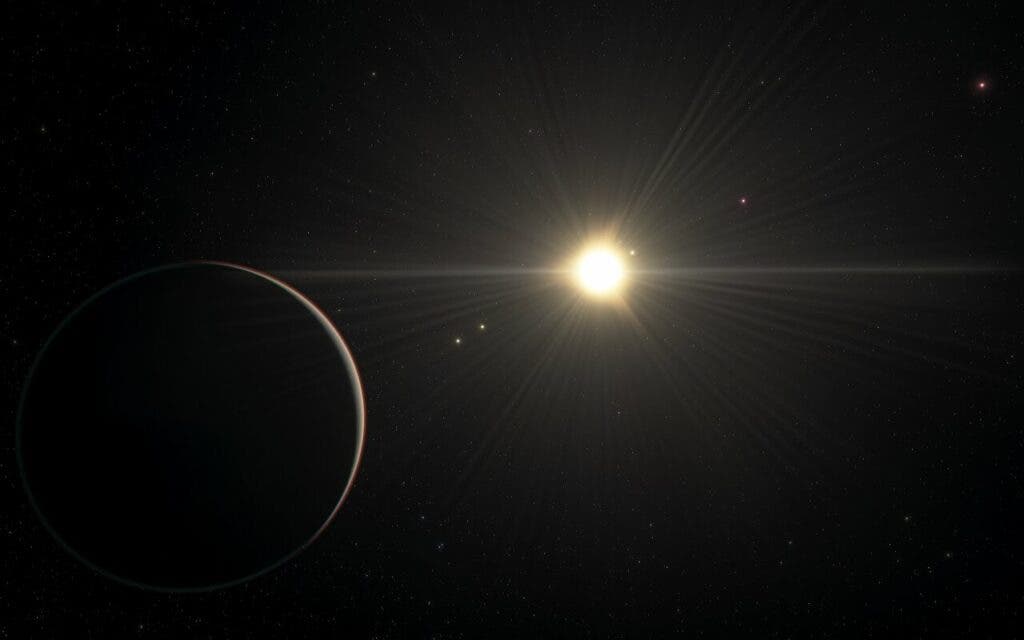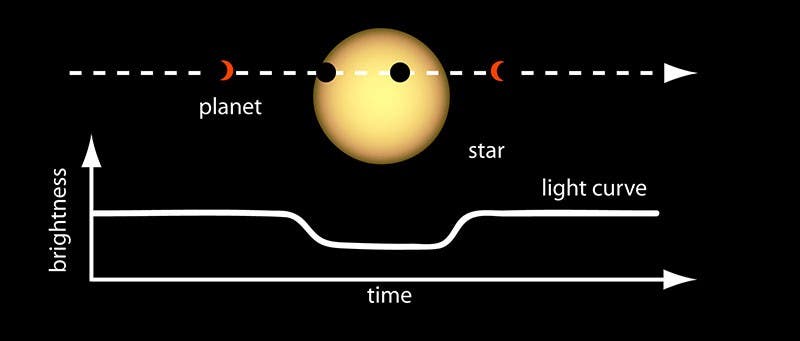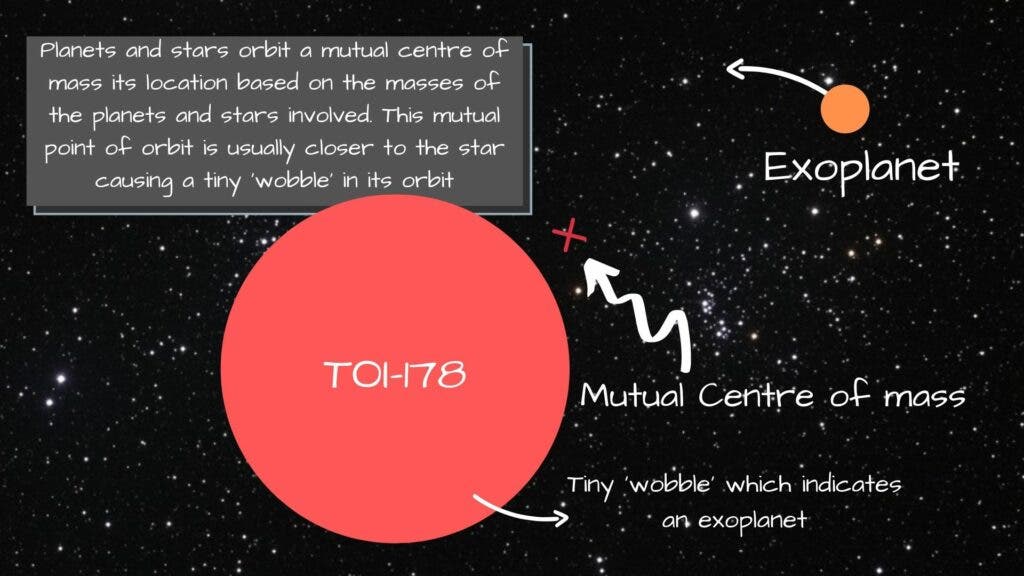Astronomers have discovered a unique system of exoplanets in which all but one of the planets orbit their parent star in a rare rhythm. The finding could force us to revise our ideas of how planets–including those in our own solar system–form.
The team–including astronomers from the University of Bern and the University of Geneva–used a combination of telescopes and the European Southern Observatory’s (ESO) Very Large Telescope (VLT) to observe the star TOI-178, 200 light-years away from us in the constellation Sculptor.

Upon first glance, the astronomers believed that the star was orbited by just two exoplanets, both of which had the same orbits. Closer inspection revealed something surprising, however — six planets, five of which are locked in a rhythmic dance with each other.
“Through further observations, we realised that there were not two planets orbiting the star at roughly the same distance from it, but rather multiple planets in a very special configuration,” says lead researcher Adrien Leleu, University of Bern.
This rhythm reveals a star system that has remained undisturbed by cosmic events since its birth. But, even within this system exists a measure of chaos, with the compositions of the constituent planets displaying some disharmonious densities that are just as rare as their harmonious orbits.
The system consists of planets ranging from one to three times the size of Earth, with masses that range from 1.5 to 30 times that of our planet. Some are rocky and larger than Earth–so-called Super-Earths. Others are gaseous like the solar system’s outer bodies, but much smaller–a class of exoplanets called Mini Neptunes.
“This contrast between the rhythmic harmony of the orbital motion and the disorderly densities certainly challenges our understanding of the formation and evolution of planetary systems,” Leleu adds.
The team’s research is published in the journal Astronomy & Astrophysics.
Exoplanets in Resonance
All the exoplanets around TOI-178, barring the one closest to the star itself, are exhibiting a resonance can be observed in the repeated patterns in their orbits. These repeating orbits mean that the planets align at regular intervals as they loop their parent star.
A similar–albeit less complex– resonance can be found in our own solar system, not with planets, but with three of the moons of Jupiter. Io completes four full orbits for every orbit of Ganymede, whilst also completing two full orbits for every orbit of Europa. This is what is known as a 4:2:1 resonance.
TOI-178’s five outer planets possess a far more complex chain of resonance than these moons, however. The exoplanets exist in an 18:9:6:4:3 resonance. This means the first exoplanet in the chain–the second closest to the star overall–completes 18 orbits as the second in the chain completes nine, the third completes six, and the fourth completes 4, and the fifth (the sixth planet overall) completes three orbits.
ESO/L. Calçada/spaceengine.org)
The team were able to take the resonance of the four planets described above and use it to discover the fifth in the chain, which is the sixth and final planet overall.
The team believes that the exoplanet’s rhythmic orbits could teach them more the system than its current state, though. It could even provide them with a window into its past. “The orbits in this system are very well ordered, which tells us that this system has evolved quite gently since its birth,” explains co-author Yann Alibert from the University of Bern.
In fact, the resonance of the system shows that it has remained relatively undisturbed since its formation. Were it to have been significantly disturbed earlier in its life–by a giant impact or the gravitational influence of another system, for example– the fragile configuration of its orbits would have been obliterated.
Disharmony and Disorder Enter the Picture
It’s not all harmony within the TOI-178 exoplanets., however. Whilst their arrangements and neat and well-ordered, the densities and compositions of the individual exoplanets are much more disordered. It’s a disorder that is very different from what we observe in our solar system.
“It appears there is a planet as dense as the Earth right next to a very fluffy planet with half the density of Neptune, followed by a planet with the density of Neptune. It is not what we are used to,” team member Nathan Hara, University of Geneva, says, describing a system comprised of Super Earths and Mini Neptunes.
As is the case with most exoplanets, the planets in the TOI-178 system were difficult to spot. The team used data collected by the European Space Agency’s CHEOPS satellite, launched in December 2019, with instruments at the VLT located in Chile’s Atacama Desert region.

In addition to this data, the team used two of the most common techniques used by astronomers to spot exoplanets. Examing the light emitted by a parent star and how it dips indicates when a planet is transitting in front of it. Also, orbits of exoplanets around a parent star can cause it to ‘wobble’–something that can be seen in its light profile.
This combination of methods allowed the team to discover that the exoplanets in TOI-178 are orbiting their parent star far more rapidly and at a much closer distance than Earth orbits the Sun.
The innermost planet, the one not part of the resonant chain, is the fastest and orbits TOI-178 in just a matter of days. The slowest has an orbit that takes ten times this period to complete.

None of the planets seems to be orbiting in what is believed to be TOI-178’s habitable zone–the area in which water can exist as a liquid. But, the team believes that studying the resonance chain could uncover additional planets in this system, some with orbits that bring them within this region.–also colourfully nicknamed the ‘Goldilocks zone’ because it is neither too hot not too cold.
The researchers will continue to investigate this unique and extraordinary system and suggest that it could be a target for intense observation with the ESO’s Extremely Large Telescope (ELT) when it begins operations later this decade.
The ELT should be able to allow researchers to directly image the exoplanets in Goldilocks zones around stars like TOI-178 as well as study their atmospheres in detail.
This could reveal that the TOI-178 holds even more secrets than this study has revealled.
Original Research
A. Leleu, Y. Alibert, N. C. Hara, et al, ‘Six transiting planets and a chain of Laplace resonances in TOI-178,’ Astronomy & Astrophysics, [2021], (doi: 10.1051/0004-6361/202039767).


